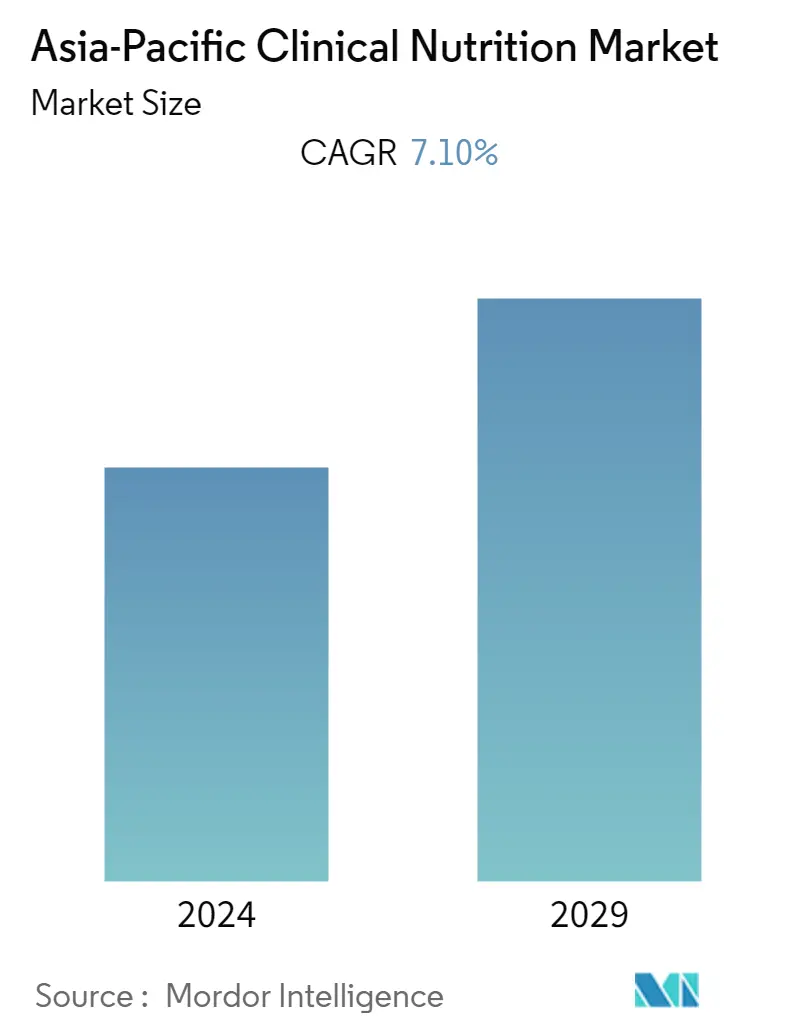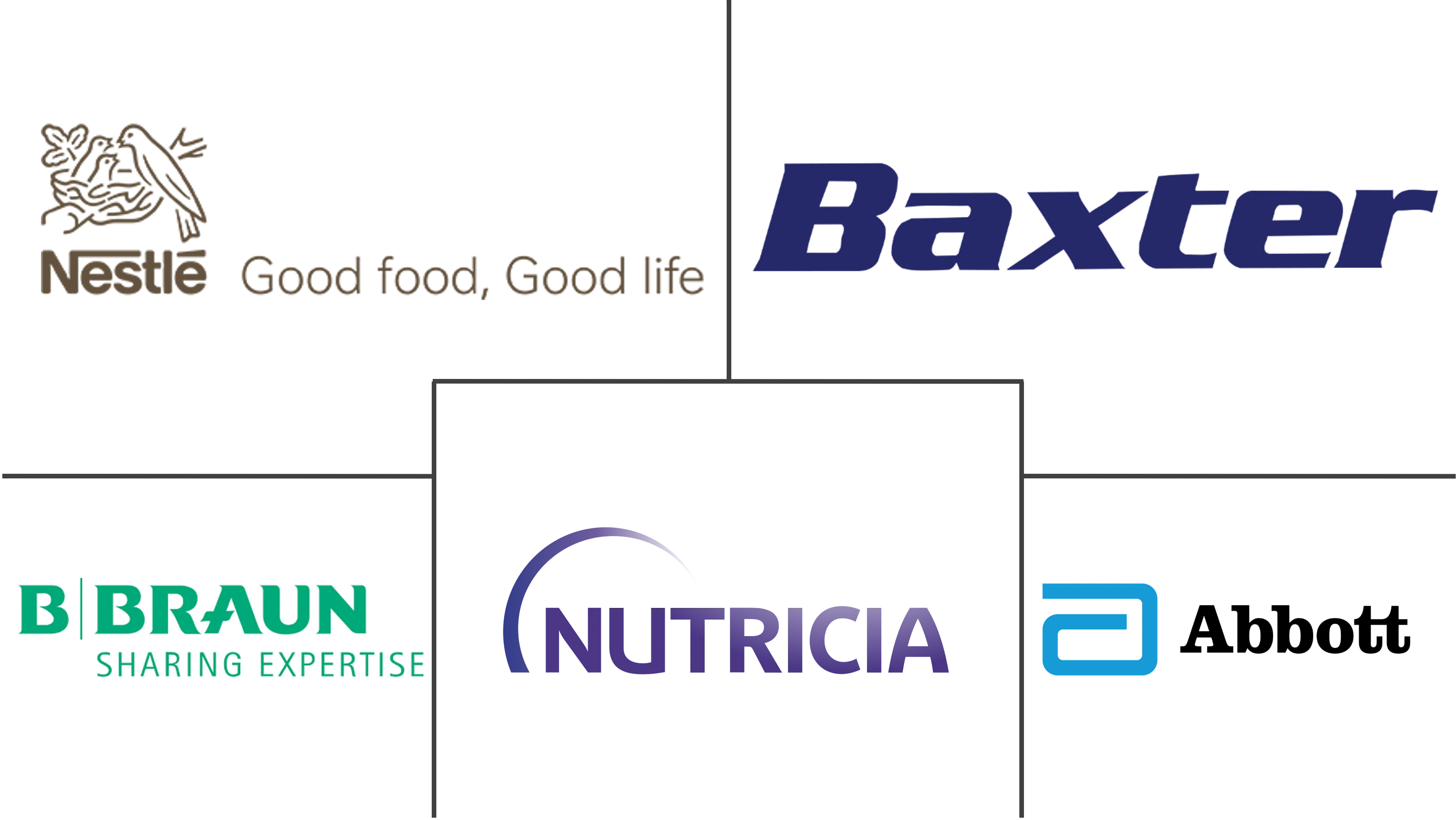Market Size of Asia-Pacific Clinical Nutrition Industry

| Study Period | 2019 - 2029 |
| Base Year For Estimation | 2023 |
| Forecast Data Period | 2024 - 2029 |
| Historical Data Period | 2019 - 2022 |
| CAGR | 7.10 % |
| Market Concentration | Low |
Major Players
*Disclaimer: Major Players sorted in no particular order |
Asia-Pacific Clinical Nutrition Market Analysis
The Asia-Pacific clinical nutrition market is expected to register a CAGR of 7.1% during the forecast period.
COVID-19 significantly impacted the market studied in the initial phase as the patients affected with COVID-19 required nutrition and a proper diet to maintain their quality of life. For instance, an article published by PubMed depicted that an effective strategy, along with proper nutrition to prevent and treat COVID-19, was anticipated to improve nutrition to strengthen the immune system. Vitamin D has been recommended to prevent COVID-19, and an intake of 250 μg/day has been shown to raise serum 25(OH)D concentrations above 40-60 ng/mL (100-150 nmol/L). Low vitamin D3 leads to an increase in anti-inflammatory and immunoregulating interleukin 10 (IL-10) cytokines. It reduces the frequency of Th17 cells, which, in turn, decreases IL-17 and proinflammatory cytokine tumor necrosis factor-alpha (TNFα) production, decreasing inflammatory effects in the host. Thus, vitamin D deficiency is often found in patients with COVID-19. The Japanese diet closely resembles a "nutrient-dense dietary pattern", and it includes a lot of elements that guard against COVID-19 infection. People have become more aware and conscious of their nutritional intake in the post-pandemic scenario, which is anticipated to drive market growth in the coming years.
The major factors attributing to the growth of the Asia-Pacific clinical nutrition market include an increase in the prevalence of metabolic disorders and neurological diseases, a rise in the geriatric population in the Asia Pacific Region, and high spending on healthcare. For instance, as per the IDF 2021 report, in India, the number of people with diabetes was 74,194.7. Furthermore, as per the same source, the total diabetes-related health expenditure in 2021 was USD 8,485.8 million.
Dietary therapy is critical for normal growth and development and to prevent acute complications. It prevents long-term complications of the given disorder. A failure to follow specific dietary treatment can lead to complications and even death in individuals with metabolic disorders. Nutrition therapy for patients with inherited metabolic disorders is lifelong. The management of patients with many inborn errors of metabolism requires a multidisciplinary approach that combines both nutrition and medical management. In these disorders, nutrition therapy is a critical component of the management to prevent acute complications, such as metabolic decompensation, and to prevent long-term complications of the given disorder.
Vitamin D deficiency is one of the major crises faced by many people and is likely to cause serious illness. The presence of competitors, mergers, acquisitions, and product launches is anticipated to boost market growth as these activities increase the availability of products and raise competition. For instance, in March 2021, Royal DSM, a purpose-led global science-based company in nutrition, health, and sustainable living, launched ampli-D, a fast-acting form of vitamin D for dietary supplements in Australia. The availability of DSM's ampli-D in Australia, the first market for its launch, follows regulatory approval by TGA for its use in dietary supplements that do not require a doctor's prescription.
Most metabolic syndromes result in situations where the body lacks the capability to synthesize non-essential molecules, like vitamins and amino acids, and several molecules involved in metabolic pathways. Most of these conditions can be managed only with the supplementation of one or two nutrients. All these factors are anticipated to boost the market growth. However, there are a few factors that may restrain market growth, such as the heterogeneous nature of government coverage/reimbursement across countries.
Asia-Pacific Clinical Nutrition Industry Segmentation
As per the scope of the report, clinical nutrition is an area of medicine that offers treatment of medical disorders caused due to an improper diet or due to the body's inability to absorb the nutrients available in a normal diet. These clinical nutrition products are aimed at treating metabolic disorders, eating or nutritional disorders, and other disorders.
The Asia-Pacific clinical nutrition market is segmented by route of administration (oral and enteral and parenteral), application (nutritional support in malnutrition, nutritional support in metabolic disorders, nutritional support in gastrointestinal diseases, nutritional support in neurological diseases, nutritional support in cancer, and nutritional support in other diseases), end-user (pediatric and adult), and geography (China, Japan, India, Australia, South Korea, Rest of Asia-Pacific). The report offers values in USD million for the abovementioned segments.
| By Route of Administration | |
| Oral and Enteral | |
| Parenteral |
| By Application | |
| Nutritional Support in Malnutrition | |
| Nutritional Support in Metabolic Disorders | |
| Nutritional Support in Gastrointestinal Diseases | |
| Nutritional Support in Neurological Diseases | |
| Nutritional Support in Cancer | |
| Nutritional Support in Other Diseases |
| By End User | |
| Pediatric | |
| Adult |
| Geography | |
| China | |
| Japan | |
| India | |
| Australia | |
| South Korea | |
| Rest of Asia-Pacific |
Asia-Pacific Clinical Nutrition Market Size Summary
The Asia-Pacific clinical nutrition market is poised for significant growth, driven by increasing awareness of nutritional intake post-COVID-19 and the rising prevalence of metabolic and neurological disorders. The market is characterized by a strong focus on dietary therapy, which is essential for managing conditions such as diabetes and metabolic disorders. The demand for clinical nutrition is further bolstered by the growing geriatric population and heightened healthcare spending in the region. Oral and enteral nutrition routes are preferred due to their ease of administration and cost-effectiveness, with oral nutritional supplements playing a crucial role in improving the quality of life for patients with conditions like dementia and cancer. The market is also witnessing increased government initiatives aimed at enhancing nutrition in economically disadvantaged areas, contributing to its expansion.
India is expected to lead the clinical nutrition market in the Asia-Pacific region, supported by its large population and rising healthcare expenditure. The country's focus on addressing neurological diseases, metabolic disorders, and cancer through nutritional supplements is a key driver of market growth. The presence of major players such as Abbott Nutrition, Nestle Health Science, and Baxter Healthcare, along with new entrants and product launches, is intensifying competition and improving product availability. The market's competitive landscape is further enriched by mergers, acquisitions, and collaborations, which are expected to enhance the development and delivery of innovative nutrition products. Overall, the Asia-Pacific clinical nutrition market is set to experience robust growth, with India playing a pivotal role in its expansion.
Asia-Pacific Clinical Nutrition Market Size - Table of Contents
-
1. MARKET DYNAMICS
-
1.1 Market Overview
-
1.2 Market Drivers
-
1.2.1 Increasing Prevalence of Metabolic Disorders
-
1.2.2 Increase in Geriatric Population in the Asia-Pacific Region
-
1.2.3 High Spending on Healthcare Along with Rise of Middle-class in Emerging Economies
-
-
1.3 Market Restraints
-
1.3.1 Unwillingness of Hospitals and In-house Pharmacies/Dispensaries to Maintain the Required Stock of Clinical Nutrition Products
-
1.3.2 Heterogeneous Nature Of Government Coverage/Reimbursement Across Countries
-
-
1.4 Porter's Five Force Analysis
-
1.4.1 Threat of New Entrants
-
1.4.2 Bargaining Power of Buyers/Consumers
-
1.4.3 Bargaining Power of Suppliers
-
1.4.4 Threat of Substitute Products
-
1.4.5 Intensity of Competitive Rivalry
-
-
-
2. MARKET SEGMENTATION (Market Size by Value - USD Million)
-
2.1 By Route of Administration
-
2.1.1 Oral and Enteral
-
2.1.2 Parenteral
-
-
2.2 By Application
-
2.2.1 Nutritional Support in Malnutrition
-
2.2.2 Nutritional Support in Metabolic Disorders
-
2.2.3 Nutritional Support in Gastrointestinal Diseases
-
2.2.4 Nutritional Support in Neurological Diseases
-
2.2.5 Nutritional Support in Cancer
-
2.2.6 Nutritional Support in Other Diseases
-
-
2.3 By End User
-
2.3.1 Pediatric
-
2.3.2 Adult
-
-
2.4 Geography
-
2.4.1 China
-
2.4.2 Japan
-
2.4.3 India
-
2.4.4 Australia
-
2.4.5 South Korea
-
2.4.6 Rest of Asia-Pacific
-
-
Asia-Pacific Clinical Nutrition Market Size FAQs
What is the current Asia-Pacific Clinical Nutrition Market size?
The Asia-Pacific Clinical Nutrition Market is projected to register a CAGR of 7.10% during the forecast period (2024-2029)
Who are the key players in Asia-Pacific Clinical Nutrition Market?
B. Braun Melsungen AG, Nutricia, Abbott, Nestlé and Baxter are the major companies operating in the Asia-Pacific Clinical Nutrition Market.

